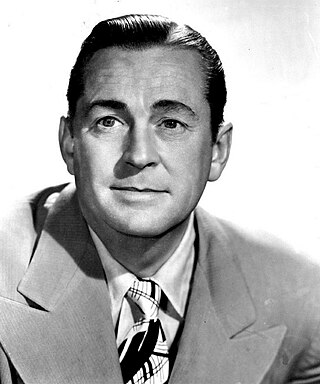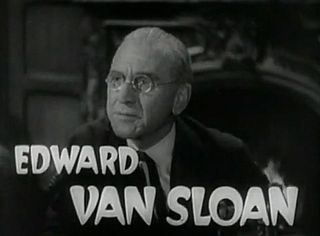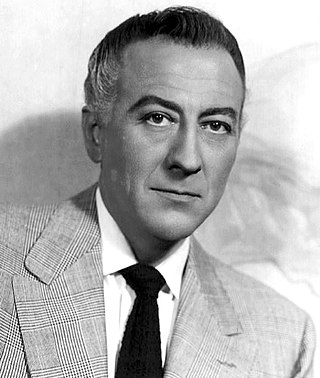Related Research Articles

Clara Lou "Ann" Sheridan was an American actress and singer. She is best known for her roles in the films San Quentin (1937) with Humphrey Bogart, Angels with Dirty Faces (1938) with James Cagney and Bogart, They Drive by Night (1940) with George Raft and Bogart, City for Conquest (1940) with Cagney and Elia Kazan, The Man Who Came to Dinner (1942) with Bette Davis, Kings Row (1942) with Ronald Reagan, Nora Prentiss (1947), and I Was a Male War Bride (1949) with Cary Grant.

James Howard Dunn, billed as Jimmy Dunn in his early career, was an American stage, film, and television actor, and vaudeville performer. The son of a New York stockbroker, he initially worked in his father's firm but was more interested in theater. He landed jobs as an extra in short films produced by Paramount Pictures in its Long Island studio, and also performed with several stock theater companies, culminating with playing the male lead in the 1929 Broadway musical Sweet Adeline. This performance attracted the attention of film studio executives, and in 1931, Fox Film signed him to a Hollywood contract.

Florence Eldridge was an American actress. She was nominated for the Tony Award for Best Actress in a Play in 1957 for her performance in Long Day's Journey into Night.

Edward Van Sloan was an American character actor best remembered for his roles in the Universal Studios horror films such as Dracula (1931), Frankenstein (1931), and The Mummy (1932).

Rochelle Hudson was an American film actress from the 1930s through the 1960s. Hudson was a WAMPAS Baby Star in 1931.

Claudia Dell was an American showgirl and actress of the stage and movies.

Sara Haden was an American actress of the 1930s through the 1950s and in television into the mid-1960s. She may be best remembered for appearing as Aunt Milly Forrest in 14 entries in the Metro-Goldwyn-Mayer Andy Hardy film series.

Dorothea Sally Eilers was an American actress.

John Emery was an American actor.

Jack La Rue was an American film and stage actor.
Murray Kinnell was a British-born American actor, recognized for playing smooth, gentlemanly, although rather shady characters. He began acting on the English stage in 1907, toured in the United States from 1912 through 1914, then returned to England where he served in the British Army during World War I. After the war, he emigrated to the US. He appeared in 71 films between the pre-code era of 1930 and 1937. He later served the Screen Actors Guild in several positions for 16 years.

Antoinette Olympe Bradna was a French dancer and actress, who emigrated to the United States where she lived for the rest of her life.

Mary Treen was an American film and television actress. A minor actress for much of her career, she managed to secure a plain, unassuming niche for herself in dozens of movies and television shows during the Hollywood of the 1940s, 1950s and 1960s in a career spanning more than 40 years.

Joan Valerie was an American actress, who appeared mainly in B movies in the late 1930s and 1940s.

The First Legion is a 1951 American drama film directed by Douglas Sirk and written by Emmet Lavery. The film stars Charles Boyer, William Demarest, Lyle Bettger, Walter Hampden, Barbara Rush, Wesley Addy, H. B. Warner and Leo G. Carroll. The film was released on April 27, 1951, by United Artists. The film was based on Lavery's play of the same name, which opened on Broadway at the 46th Street Theatre on October 1, 1934. The play, which had no female characters, moved to the Biltmore Theater where it closed January 5, 1935.
Ruth Matteson was an American actress. She appeared in more than 20 Broadway plays and had a variety of television roles.

Ami Mali Hicks (1867–1954) was an American feminist, writer, and organizer. She wrote books on art instruction and criticism. Hicks was a longtime administrator for Free Acres, an independent, collectivized community in New Jersey. She worked with the Women’s Political Union and was a member of Heterodoxy, two radical organizations that challenged some of the more placid activism of women’s movements and suffragists.

Lola Lane was an American actress and one of the Lane Sisters with her sisters Leota, Rosemary, and Priscilla Lane. She appeared on Broadway and in films from the 1920s to 1940s.

Norma Stafford Mitchell was an American actress and writer.
Boy Meets Girl is a three-act, seven-scene play, written by Bella and Samuel Spewack, staged and produced by George Abbott. It is a farce with a large cast, fast pacing, two settings and a film sequence. The action centers around two scenarists at the Royal Studios in Hollywood, their volatile producer, the fading western actor they write for, and a pregnant single waitress whose baby they turn into a film star. The play's title comes from a trope common to early film plots: Boy Meets Girl, Boy Loses Girl, Boy Gets Girl. Though not original to the play, the phrase received a boost in popular usage as a result.
References
Synopsis source
- Wilbur Daniel Steele and Norma Mitchell (1935). Post Road: A Play in Two Acts. Samuel French, Inc.
Citations
- 1 2 "Lucille Watson". Daily News. New York, New York. November 7, 1934. p. 637 – via Newspapers.com.
- 1 2 "Drama News". Times Union. Brooklyn, New York. May 25, 1935. p. 17 – via Newspapers.com.
- 1 2 3 Atkinson, Brooks (December 5, 1934). "The Play". The New York Times. New York, New York. p. 28 – via NYTimes.com.
- ↑ "'Any Woman'". The Brooklyn Daily Eagle. Brooklyn, New York. August 28, 1934. p. 9 – via Newspapers.com.
- ↑ "Theater News". The Brooklyn Daily Eagle. Brooklyn, New York. October 27, 1934. p. 15 – via Newspapers.com.
- ↑ "Truex, Connolly In Howard Play About "Insull"". Daily News. New York, New York. October 28, 1934. p. 248 – via Newspapers.com.
- 1 2 Field, Rowland (December 5, 1934). "The New Play". Times Union. Brooklyn, New York. p. 9 – via Newspapers.com.
- ↑ "Drama News". Times Union. Brooklyn, New York. November 14, 1934. p. 9 – via Newspapers.com.
- 1 2 3 4 5 6 7 8 9 10 11 12 13 14 15 16 Pollock, Arthur (December 5, 1934). "The Theater". The Brooklyn Daily Eagle. Brooklyn, New York. p. 21 – via Newspapers.com.
- 1 2 "News of the Stage". Brooklyn Daily Eagle. Brooklyn, New York. May 7, 1935. p. 25 – via Newspapers.com.
- 1 2 3 4 5 6 7 8 9 10 11 12 13 14 15 16 "Drama News". Times Union. Brooklyn, New York. May 30, 1935. p. 13 – via Newspapers.com.
- 1 2 3 "Theater News". The Brooklyn Daily Eagle. Brooklyn, New York. March 28, 1935. p. 13 – via Newspapers.com.
- 1 2 "Drama News". Times Union. Brooklyn, New York. February 8, 1935. p. 12 – via Newspapers.com.
- 1 2 "Theatre Notes". Daily News. New York, New York. April 19, 1935. p. 232 – via Newspapers.com.
- 1 2 3 4 "Drama News". Times Union. Brooklyn, New York. May 23, 1935. p. 17 – via Newspapers.com.
- ↑ Price, Edgar (December 5, 1934). "The Premiere". The Brooklyn Citizen. Brooklyn, New York. p. 16 – via Newspapers.com.
- 1 2 Mantle, Burns (December 5, 1934). ""Post Road" Produces a Mystery". Daily News. New York, New York. p. 178 – via Newspapers.com.
- ↑ ""Post Road" Moves". Times Union. Brooklyn, New York. February 18, 1935. p. 7 – via Newspapers.com.
- 1 2 "Drama News". Times Union. Brooklyn, New York. March 27, 1935. p. 17 – via Newspapers.com.